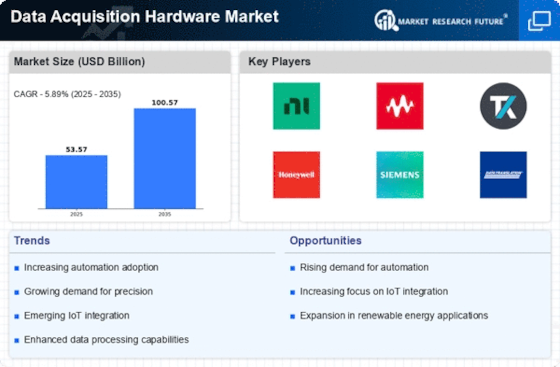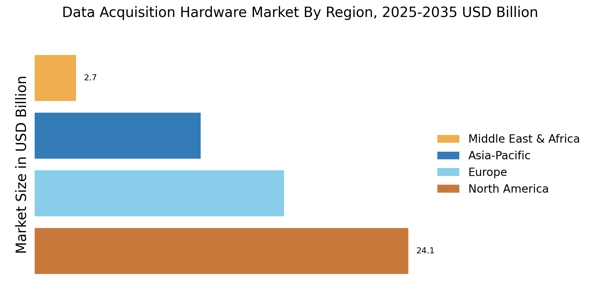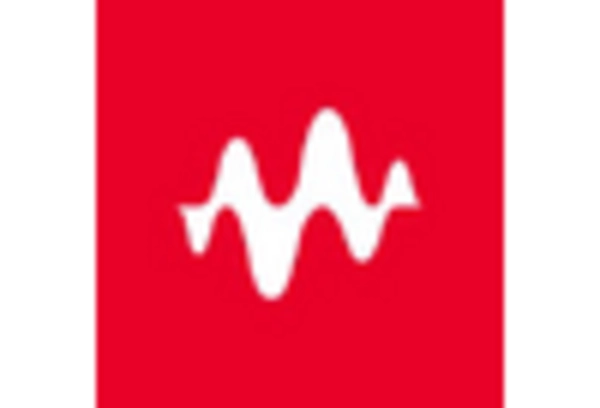Rising Demand for Automation
The increasing demand for automation across various industries is a primary driver of the Data Acquisition Hardware Market. As organizations strive to enhance operational efficiency and reduce human error, the need for sophisticated data acquisition systems becomes paramount. Industries such as manufacturing, healthcare, and transportation are investing heavily in automation technologies, which in turn fuels the demand for data acquisition hardware. According to recent estimates, the automation market is projected to grow at a compound annual growth rate of over 9%, indicating a robust expansion that will likely benefit the data acquisition sector. This trend suggests that companies are prioritizing investments in data acquisition systems to facilitate real-time monitoring and control, thereby enhancing productivity and decision-making processes.
Emergence of Smart Manufacturing
The emergence of smart manufacturing is a pivotal driver for the Data Acquisition Hardware Market. As industries adopt Industry 4.0 principles, the integration of advanced technologies such as IoT, AI, and machine learning is becoming commonplace. Smart manufacturing relies heavily on data acquisition systems to collect and analyze data from various sources, enabling real-time decision-making and process optimization. Market analysis indicates that the smart manufacturing sector is expected to witness substantial growth, with investments in data acquisition hardware playing a crucial role in this transformation. The shift towards interconnected systems and automated processes suggests that the demand for robust data acquisition solutions will continue to rise, as manufacturers seek to enhance productivity and reduce operational costs.
Advancements in Sensor Technology
Technological advancements in sensor technology are significantly influencing the Data Acquisition Hardware Market. The development of more sensitive, accurate, and versatile sensors enables the collection of a broader range of data types, which is essential for various applications, including environmental monitoring, industrial automation, and smart cities. The integration of advanced sensors with data acquisition systems allows for improved data fidelity and real-time analytics. Market data indicates that the sensor market is expected to reach a valuation of approximately 200 billion dollars by 2026, which underscores the potential for growth in the data acquisition hardware sector. As industries increasingly rely on precise data for operational insights, the demand for advanced data acquisition hardware that can effectively interface with these sensors is likely to rise.
Regulatory Compliance and Standards
Regulatory compliance and adherence to industry standards are increasingly influencing the Data Acquisition Hardware Market. Many sectors, including pharmaceuticals, food and beverage, and environmental monitoring, are subject to stringent regulations that necessitate accurate data collection and reporting. As organizations strive to meet these compliance requirements, the demand for reliable data acquisition systems that ensure data integrity and traceability is likely to increase. The need for compliance with standards such as ISO and FDA regulations drives investments in data acquisition hardware that can provide the necessary documentation and validation. This trend suggests that companies are prioritizing the acquisition of hardware solutions that not only meet regulatory demands but also enhance their operational capabilities.
Growing Importance of Data Analytics
The growing importance of data analytics in decision-making processes is a significant driver for the Data Acquisition Hardware Market. Organizations are increasingly recognizing the value of data-driven insights to enhance operational efficiency, customer satisfaction, and competitive advantage. As a result, there is a heightened demand for data acquisition systems that can capture, process, and analyze large volumes of data in real-time. The analytics market is projected to grow substantially, with estimates suggesting a compound annual growth rate of around 25% over the next few years. This growth indicates that businesses are investing in data acquisition hardware to support their analytics initiatives, thereby driving the demand for sophisticated data acquisition solutions that can handle complex data sets and provide actionable insights.


















Leave a Comment